Archaeopteryx Misconception
Evolutionists point to the Archaeopteryx fossil as the only evidence to support their claim that "birds evolved from dinosaurs". The latest discoveries, however, prove that this creature is simply an extinct bird species.
The most important intermediate form candidate that evolutionists refer to is a 150 million-year-old fossil bird called Archaeopteryx. Evolutionists claim that this fossil bird was a semi-dinosaur which could not fly properly.
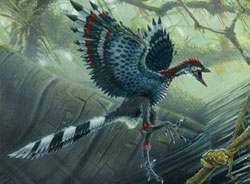 | 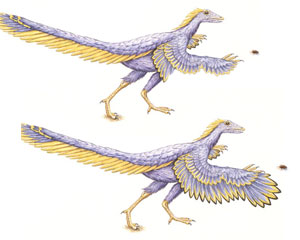 |
A reconstruction of Archaeopteryx |
This evolutionist claim proven false over and over again, collapsed for good with an Archaeopteryx fossil unearthed in 1992.
The absence of a "sternum", that is the chest bone, in this creature, which is essential for flight muscles, was held up as the most important evidence that this bird could not fly properly. The seventh Archaeopteryx fossil unearthed in 1992 revealed that the chest bone that evolutionists have long assumed to be missing actually existed. The presence of this bone proved that Archaeopteryx was a flying bird. 34
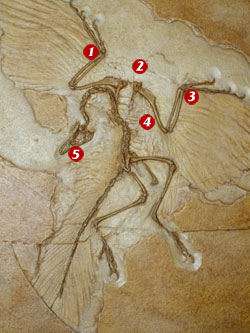 |
1. The bones are hollow as in modern birds. 2. Feathers indicate that Archaeopteryx is a warm-blooded and flying creature. 3. The newly discovered 7th specimen of Archaeopteryx preserves a keeled sternum, which indicates that this bird had strong flight muscles like modern flying birds. 4. Some birds today also have similar "claws" on their wings. 5. The teeth in its jaw are no evidence of its alleged relationship with reptiles. Analyses show that the tooth structure of Archaeopteryx was very different from that of modern reptiles.
|
In addition, it has been proved that two other points which evolutionists mention while presenting Archaeopteryx as an intermediate form – the claws on its wings and the teeth in its mouth – do not in any way imply that this bird is an intermediate form. It has been observed that two bird species living today, touraco and hoatzin both have claws on their wings by which to hold on to branches.
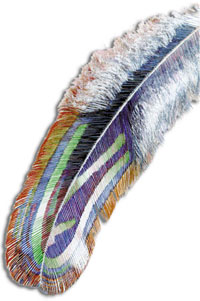 | TALES FROM EVOLUTIONISTS Under the pretence of being scientific, evolutionists often allege that "small dinosaurs took wing and became birds." However, their explanation of how this transformation took place is practically a fairy tale. As these evolutionist sketches illustrate, they say that some dinosaurs who flapped their front legs to hunt flies gradually "took wing". A sheer figment of the imagination, this scenario brings along an interesting question with it: How then did flies, which were not only already flying but also displaying an aerodynamic wonder by fluttering their wings 500 times a second synchronously, take wing? ASYMMETRIC FEATHERS The feathers of all modern flying birds are asymmetric. This form gives an aerodynamic function to birds. The fact that Archaeopteryx's feathers were also asymmetric invalidates the evolutionary claim that this bird could not fly. |
Also, there have been different bird species throughout history that had teeth. Moreover, according to the measurements of famous ornithologists, such as Martin, Stewart and Whetstone, the tooth structure of Archaeopteryx was completely different from that of reptiles.35 All these findings show that the evolutionary claims that Archaeopteryx is an intermediate form have no scientific basis.
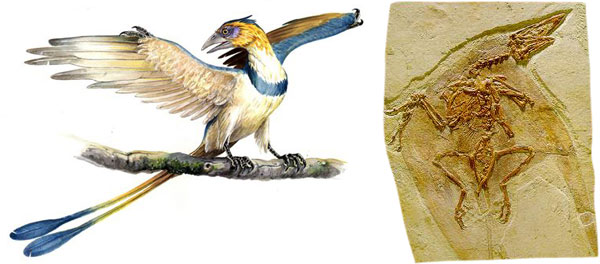 |
OTHER TOOTHLESS BEAKS Confuciusornis, whose fossil is seen here, lived in the same geological period as Archaeopteryx. Unlike Archaeopteryx, however, it had no teeth in its beak. This discovery revealed that Archaeopteryx was not "primitive", but was an original bird species. Confuciusornis fossil and an illustration of the bird HOATZIN'S CLAWS Some bird species living today have features similar to those of Archaeopteryx. For instance, the hoatzin bird also has claw-like structures on its wings. Hoatzin |
Footnotes
34) Nature, Band 382, 1 August 1996, S. 401
35) L. D. Martin, J. D. Stewart, K. N. Whetstone, The Auk, Band 98, 1980, S. 86.
- An Outdated View: The Theory of Evolution
- The Origin of Life
- The Design in the Protein
- The Design in the Cell
- Genetic Information
- The Design in Nature
- Miller's Experiment
- The Natural Selection Misconception
- Mutations
- Irreducible Complexity
- Impasse of Intermediate Forms
- The Cambrian Period
- Fish and Amphibians
- Coelacanth Misconception
- Reptiles
- Birds and Reptiles
- Archaeopteryx Misconception
- Bird Feathers
- The Origin of Mammals
- Living Fossils
- The Tale of Man's Evolution
- Australopithecus
- Homo Erectus
- A Lost Human Race: Neanderthals
- The Collapse of the Family Tree
- The Bipedalism Impasse
- False Faces
- Piltdown Scandal
- Why is Evolution Defended?
- The Obvious Truth: Creation
